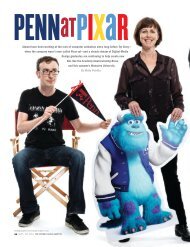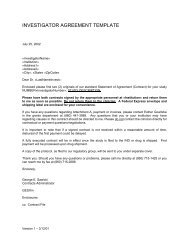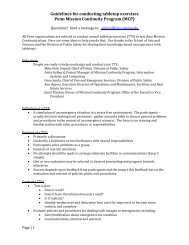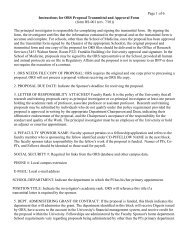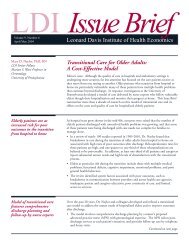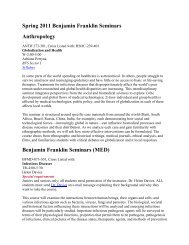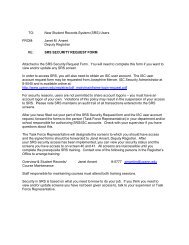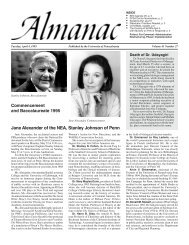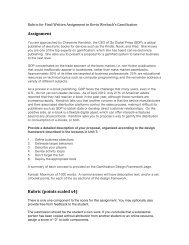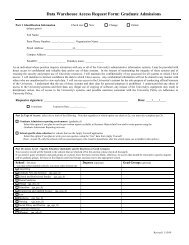No. 3 September 13, 1994 - University of Pennsylvania
No. 3 September 13, 1994 - University of Pennsylvania
No. 3 September 13, 1994 - University of Pennsylvania
- No tags were found...
You also want an ePaper? Increase the reach of your titles
YUMPU automatically turns print PDFs into web optimized ePapers that Google loves.
enchmarksReinvesting in Penn: Administrative RestructuringLast week I set in motion a major initiative focusing on enhancing Penn’s administrativeeffectiveness and cost efficiency as part <strong>of</strong> our effort to strenthen our core mission <strong>of</strong> academicexcellence. Through a careful and systematic process, we will seek to establish a sound financialbase and supportive management structure and to reallocate monies from administrative functionsto academic pursuits. That will provide clear evidence <strong>of</strong> our priorities at Penn.When I arrived at Penn, I learned that my predecessor, Claire Fagin, had retained thepr<strong>of</strong>essional services firm <strong>of</strong> Coopers & Lybrand to study Penn’s administrative operations. Iwas quickly impressed by the work that they had done, and by their understanding <strong>of</strong> Penn and <strong>of</strong>the intricate workings <strong>of</strong> our community. To get further benefit from their efforts, I decided to pursue the following additionalinitiatives this fall:• First, to expand Coopers & Lybrand’s mandate to include a strategic look at all <strong>of</strong> our business and administrativeprocesses in a broad range <strong>of</strong> functions and activities.• Second, to establish an extensive consultation process to ensure that Coopers & Lybrand’s work addresses the needsand concerns <strong>of</strong> the Penn community, and generates broad support from our various constituencies.• Third, to develop an action plan with practical recommendations that can be implemented on a realistic timetable.I have asked the Cost Containment Oversight Committee, which was created two years ago at the suggestion <strong>of</strong> the FacultySenate, to become the primary interface with Coopers & Lybrand in the first phase <strong>of</strong> this process, and I have expanded its membershipsomewhat. The Cost Containment Oversight Committee over the past few years has gained a significant understanding <strong>of</strong> theproblems and complexities <strong>of</strong> changing Penn’s operations. I am confident that the considerable experience and talents representedon the Committee will ensure that its work is realistic and credible. This will require a significant commitment <strong>of</strong> time and effort byeach Committee member and I am deeply grateful to them for undertaking this task on behalf <strong>of</strong> all <strong>of</strong> us.The issues to be reviewed will involve many difficult choices regarding priorities for the future, the impact <strong>of</strong> changingtraditional methods <strong>of</strong> delivering administrative services and the appropriate balance between convenience and cost for variousservices and functions. It is critical that we adopt a <strong>University</strong>-wide perspective on these issues. If our goal is to reinvest inacademics, then we all must be prepared to adhere to certain common institutional objectives, strategies and standards that willbring benefits to all our constituent schools. The <strong>University</strong>’s deans have been consulted on this initiative. They have respondedenthusiastically, and I know they will provide invaluable guidance and strong leadership as we move forward.I also know that this is not the first attempt to tackle these issues at Penn. There has been a lot <strong>of</strong> activity over the pasttwo years and some important achievements. Penn’s committment to administrative restructuring has a greater chance <strong>of</strong> succedingbecause <strong>of</strong> this experience and our undertstanding that the process must include careful coordination and consultation at every step.By early <strong>No</strong>vember, Coopers & Lybrand will submit to me a detailed report with its findings and recommendations.I intend to disseminate the report widely throughout the <strong>University</strong>, and have it available in every possible way from librariesto on-line. We will then engage in a broader consultation process through meetings and discussions on specific issues. I willmake one promise. This will not be just “another study.” It will not produce a handsome report that sits on a shelf. Thisprocess will have an aggressive timetable for review, decision-making and implementation.While we will consult with faculty, staff, students and others, we cannot let consultation and debate substitute for action.Some decisions can be made promptly. Others will involve complex implementation plans and we will set in place groupsto work on each <strong>of</strong> these various issues.My responsibility will be to manage the decision-making process to ensure that issues are presented for decision andresolved on a timely basis at an appropriate level—whether the deans, the Executive Vice President, the Provost, myself orthe Board <strong>of</strong> Trustees.For Penn to thrive in the years ahead, we must demonstrate convincingly that we are managing efficiently and investingwisely. Those who work here and look for funding for new research, teaching and program initiatives must believe that ourpriorities are sound and academically-based. Those who oversee our affairs on the Board <strong>of</strong> Trustees and who generouslycontribute to our activities must have confidence in our stewardship. And those who entrust us with their children and bearthe dear cost <strong>of</strong> tuition must understand that we take seriously our obligation to make the most <strong>of</strong> our resources to educateour students.This will be an open process, and I urge all <strong>of</strong> you to participate. We welcome comments and suggestions, and wewill look for your support. As we move forward, it is imperative that Penn develop a consensus for action and reformacross the <strong>University</strong>. I am confident we can achieve that.Members <strong>of</strong> the Cost Containment Oversight CommitteeDr. Stanley A. Chodorow, Provost (Co-Chair)Dr. Jack Freeman, Acting Executive Vice President (Co-Chair)Dr. Houston Baker, Albert M. Greenfield Pr<strong>of</strong>essor <strong>of</strong> Human RelationsDr. Marshall E. Blume, Howard Butcher Pr<strong>of</strong>essor <strong>of</strong> FinanceDr. Gregory Farrington, Dean, School <strong>of</strong> Engineering and Applied ScienceDr. Raymond J. Fonseca, Dean, School <strong>of</strong> Dental MedicineDr. Sherman Frankel, Pr<strong>of</strong>essor Emeritus <strong>of</strong> PhysicsDr. Thomas Gerrity, Dean, Wharton SchoolMr. Stephen T. Golding, Vice President for FinanceDr. John Wells Gould, Vice President and Director <strong>of</strong> PlanningDr. Patrick T. Harker, Pr<strong>of</strong>essor <strong>of</strong> Operations and Information ManagementDr. <strong>No</strong>rma M. Lang, Dean, School <strong>of</strong> NursingDr. Jean Morese, Deputy to the PresidentDr. Lee D. Peachey, Pr<strong>of</strong>essor <strong>of</strong> BiologyJudith Rodin, PresidentAlmanac <strong>September</strong> <strong>13</strong>, <strong>1994</strong>



